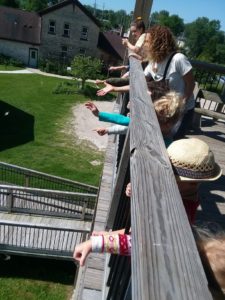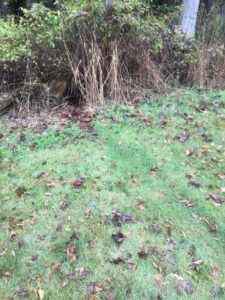In addition to pleasant temperatures and colorful foliage, autumn is the time when many plants, having stored the abundant energy from the sun, produce their seeds. Seeds seem so ordinary, but are really little miracles of reproduction. Plants have developed many different ways of packaging up their genetic fingerprints, along with a bit of nutrition to sustain their offspring for a while as they start their new lives, and, they come in armored packaging in many cases. Some seeds just fall from their parents to lie on the ground in hope of landing in a suitable spot, while others are equipped with some means- wings or parachutes to help them fly, or spring-loaded pods to eject them to new soil, or even hooks with which to latch onto passing animals. In these ways, they spread over the landscape, an advantage to their species in case a disaster happens in one location they inhabit.

Dropping milkweed seeds from the tower
Children love to learn, and often when they visit our center in fall we talk to them about seeds and how they are dispersed. We’re fortunate to have many milkweed plants growing around our headquarters which now sport ripe pods full of seeds, each equipped with it’s own parachute. The culmination of our lessons about seeds is to climb our observation tower with the children so that they can help the milkweeds spread by launching their seeds into the wind. I think launching the parachutes and watching them float away is as much fun for the teachers as it is for the kids- or perhaps it’s the fun of seeing the children enjoy the activity so much. As always, we hope this fun makes them think a little about how interesting and special such simple things are. Children have the ability to find the interest and enjoyment of such things- even the colors and sounds and smells of the leaves on the ground in ways that we adults no longer take time for, but should. Our educators, both staff and volunteers, realize that and sometimes the lesson plans are forsaken in lieu of something unexpected and really interesting, like leaves on the ground.
Our land restoration staff and helpers also spend a lot of time thinking about seeds – mostly how to enrich the diversity of species of wildflowers and wetland plants in areas we’re trying to fix ecologically. Trying to anticipate what plants to grow and how to plant them is a challenge. Sometimes those specialized seeds defy the workings of a broadcast seeder or grain drill, and have to be spread by hand over fields.

squirrel trail
Sometimes we welcome the help of non-human volunteers to assist with seeding. In swamp forests, black walnut trees are often a component of the overstory, and are one species that can be used to replace ash trees imperiled by the emerald ash borer. One of our supporters brought a bucket of walnuts for planting, but they need to have the husks removed and the nuts buried, a messy job. At the same time we noticed a gray squirrel, or squirrels, often bringing walnuts across Columbus Street into the preserve. This time of year squirrels work hard at gathering walnuts, removing the husks with their teeth, and burying them in various locations to hide them from others, saving them for later meals. The squirrels often bury more than they need, or forget where they put them, but the result is a scattering of walnut saplings in a few years. These squirrels, along with other animals, have worn a trail in the mowed turf alongside the street where they enter the woods. Not being ashamed at recruiting their help, we deposited a bucket of walnuts at the forest edge along their trail. Sure enough the walnuts disappeared, and we assume some happy squirrels, thinking they have struck the motherlode, took and distributed the nuts into the woods for us. This will, we hope, add another native species to that part of the forest, and over time will benefit the squirrels too. I’m sure a few nuts are eaten along the way, but we are not above bribing our volunteers when necessary!
There are many such interactions among the millions of plants and animals that call the 1,400 acres of Woodland Dunes home. Being aware, and being a part of that, is as interesting and fun for we adults as it is for the children who visit.
photos- Jessica Johnsrud, Education Coordinator, with children releasing milkweed seeds off the tower, trail off Columbus St. used by squirrels to hide food in the forest.
—
Jim Knickelbine
Executive Director
Woodland Dunes Nature Center and Preserve
